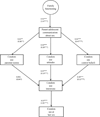Predicting condom use attitudes, norms, and control beliefs in Hispanic problem behavior youth: the effects of family functioning and parent-adolescent communication about sex on condom use
- PMID: 22561377
- PMCID: PMC3584180
- DOI: 10.1177/1090198112440010
Predicting condom use attitudes, norms, and control beliefs in Hispanic problem behavior youth: the effects of family functioning and parent-adolescent communication about sex on condom use
Abstract
Hispanic problem behavior youth are at an increased risk of engaging in HIV risk behaviors, including low condom use. However, relatively little research has examined factors that affect condom use in this population. Although research indicates that family processes, such as higher levels of family functioning and open parent-adolescent communication about sex, and condom use attitudes, norms, and control beliefs as depicted by the theory of planned behavior have an effect on condom use behaviors, the combination of the two factors has received minimal attention. The purpose of this study was to examine the effect of family functioning on condom use intentions and behaviors through communication about sex and condom use attitudes, parental norms, and control beliefs. A cross-sectional study of 171 predominately male (73.1%) sexually active Hispanic problem behavior adolescents (mean age = 14.88 years) was conducted. Structural equation modeling was used to test the study hypothesis. Findings largely support the overall model and suggest that family functioning had an indirect effect on condom use intention and behavior through communication about sex, condom use attitudes, and control beliefs. Family functioning, however, did not have an indirect effect on condom use intention and behavior through communication about sex and parental norms. Implications for prevention science and future research are discussed.
Keywords: HIV/AIDS; Latino; adolescents; behavioral theories; race/ethnicity; sex behavior; theory of planned behavior.
Conflict of interest statement
The authors declared no potential conflicts of interest with respect to the research, authorship, and/or publication of this article.
Figures
Similar articles
-
Attitudes, norms, and self-efficacy: a model of adolescents' HIV-related sexual risk behavior.Health Educ Q. 1992 Summer;19(2):263-77. doi: 10.1177/109019819201900209. Health Educ Q. 1992. PMID: 1618632
-
Sexual risk among Colombian adolescents: knowledge, attitudes, normative beliefs, perceived control, intention, and sexual behavior.BMC Public Health. 2018 Dec 17;18(1):1377. doi: 10.1186/s12889-018-6311-y. BMC Public Health. 2018. PMID: 30558584 Free PMC article.
-
Predictors of sexual intercourse and condom use intentions among Spanish-dominant Latino youth: a test of the planned behavior theory.Nurs Res. 2004 May-Jun;53(3):172-81. doi: 10.1097/00006199-200405000-00004. Nurs Res. 2004. PMID: 15167505 Clinical Trial.
-
Adolescent condom use, the health belief model, and the prevention of sexually transmitted disease.J Obstet Gynecol Neonatal Nurs. 1996 Jan;25(1):61-6. doi: 10.1111/j.1552-6909.1996.tb02514.x. J Obstet Gynecol Neonatal Nurs. 1996. PMID: 8627404 Review.
-
Young adults, alcohol and condom use: what is the connection?J Adolesc Health. 1994 May;15(3):238-44. doi: 10.1016/1054-139x(94)90509-6. J Adolesc Health. 1994. PMID: 8075094 Review.
Cited by
-
The Usability and Acceptability of an Adolescent mHealth HIV/STI and Drug Abuse Preventive Intervention in Primary Care.Behav Med. 2018 Jan-Mar;44(1):36-47. doi: 10.1080/08964289.2016.1189396. Epub 2016 Jul 15. Behav Med. 2018. PMID: 27223646 Free PMC article.
-
USING THE THEORY OF PLANNED BEHAVIOR TO DETERMINE THE CONDOM USE BEHAVIOR AMONG COLLEGE STUDENTS.Am J Health Stud. 2015;30(1):43-50. Am J Health Stud. 2015. PMID: 26512197 Free PMC article.
-
Relationship between chronotype and mental behavioural health among adolescents: a cross-sectional study based on the social ecological system.BMC Psychiatry. 2023 Jun 6;23(1):404. doi: 10.1186/s12888-023-04879-6. BMC Psychiatry. 2023. PMID: 37280607 Free PMC article.
-
Resiliency theory: a strengths-based approach to research and practice for adolescent health.Health Educ Behav. 2013 Aug;40(4):381-3. doi: 10.1177/1090198113493782. Health Educ Behav. 2013. PMID: 23863911 Free PMC article. No abstract available.
-
Factors Influencing Participation and Engagement in a Teen Safe Driving Intervention: A Qualitative Study.Int J Environ Res Public Health. 2024 Jul 16;21(7):928. doi: 10.3390/ijerph21070928. Int J Environ Res Public Health. 2024. PMID: 39063504 Free PMC article.
References
-
- Ajzen I. The theory of planned behavior. Organizational Behavior and Human Decision Processes. 1991;50:179–211.
-
- Armitage CJ, Conner M. Efficacy of the theory of planned behaviour: A meta-analytic review. British Journal of Social Psychology. 2001;40:471–499. - PubMed
-
- Atienzo EE, Walker DM, Campero L, Lamadrid-Figueroa H, Gutierrez JP. Parent-adolescent communication about sex in Morelos, Mexico: Does it impact sexual behaviour? European Journal of Contraception & Reproductive Health Care. 2009;14:111–119. - PubMed
-
- Barnes HL, Olson DH. Parent–adolescent communication and the circumplex model. Child Development. 1985;56:438–447.
Publication types
MeSH terms
Grants and funding
LinkOut - more resources
Full Text Sources
Medical


